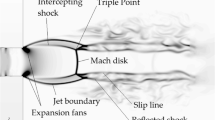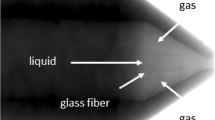Abstract
A computational fluid dynamics (CFD) model for a supersonic oxygen jet has been developed with detailed consideration of compressible flow properties and ambient temperature conditions. The model was validated by comparison of the axial velocity of the supersonic jet predicted by the CFD model with experimental measurements under different ambient temperatures. The effects of the turbulence model were studied. A modified standard k–epsilon model was used to consider turbulence mixing due to both compressibility and the temperature gradient. Overall, the predictions of the CFD model showed good agreement with experimental measurements for all temperature conditions. The potential core length of the supersonic oxygen jet was studied and compared with the results of empirical models, indicating good agreement with that used by Sumi et al. Parametric study on the ambient temperature was conducted, revealing that the potential core length of the supersonic oxygen jet increases linearly with the ambient temperature.










Similar content being viewed by others
Abbreviations
- \( p \) :
-
Static pressure, Pa
- \( \rho \) :
-
Density, kg/m3
- \( \vec{v} \) :
-
Fluid velocity, m/s
- \( \vec{F} \) :
-
External body force, N
- \( \vec{g} \) :
-
Gravity, m/s2
- \( \overline{\overline{\tau }} \) :
-
Stress tensor
- \( \mu \) :
-
Molecular viscosity, kg/m s
- \( \delta_{ij} \) :
-
Stress tensor due to molecular viscosity
- \( I \) :
-
Unit tensor
- \( E \) :
-
Total energy
- \( k_{\text{eff}} \) :
-
Effective conductivity, W/m-K
- \( h_{j} \) :
-
Sensible enthalpy of species j
- \( \vec{J}_{j} \) :
-
Diffusion flux of species j
- \( { \Pr }_{\text{t}} \) :
-
Turbulent Prandtl number
- \( S_{\text{h}} \) :
-
Heat of chemical reaction, and any other volumetric heat sources, J
- \( C_{p,j} \) :
-
Temperature-dependent constant-pressure specific heat of species j
- \( k \) :
-
Turbulence kinetic energy, m2/s2
- \( \varepsilon \) :
-
Turbulence dissipation rate, m2/s3
- \( \sigma_{k} \) :
-
Turbulent Prandtl number for \( k \), 1.0
- \( \sigma_{\varepsilon } \) :
-
Turbulent Prandtl number for \( \varepsilon \), 1.3
- \( \mu_{\text{t}} \) :
-
Turbulent viscosity, kg/ms
- \( M_{t} \) :
-
Turbulent Mach number
- \( a \) :
-
Speed of sound, m/s
- \( u_{j} \) :
-
Velocity component along direction \( x_{j} \), m/s
- \( u_{i}^{'} \) :
-
Instant turbulence velocity on direction \( x_{i} \), m/s
- \( T \) :
-
Local temperature, K
- \( T_{\text{t}} \) :
-
Local total temperature, K
- \( T_{\text{g}} \) :
-
Normalized local total temperature gradient
- \( Y_{i} \) :
-
Local mass fraction of each species
- \( R_{i} \) :
-
Net rate of production of species i by chemical reactions
- \( \vec{J}_{i} \) :
-
Diffusion flux term of species i
- \( D_{{i,{\text{m}}}} \) :
-
Diffusion coefficient for species i in the mixture
- \( D_{T,i} \) :
-
Thermal diffusion coefficient
- \( {\text{Sc}}_{\text{t}} \) :
-
Turbulent Schmidt number, 0.7
- \( Y_{i}^{*} \) :
-
Mass fraction of species \( i \) within the fine structures after reacting over the time \( \tau^{*} \)
- \( Y_{i}^{0} \) :
-
Mass fraction of species \( i \) in the fluid surrounding the fine structures
- \( v \) :
-
Kinematic viscosity, m2/s
References
P. Mathur and C. Messina, AISE Steel Technol. 78, 21 (2001).
I. Sumi, Y. Kishimoto, Y. Kikichi, and H. Igarashi, ISIJ Int. 46, 1312 (2006).
S. Ito and I. Muchi, Tetsu-To-Hagane 55, 1152 (1969).
J.M. Seiner, M.K. Ponton, B.J. Jansen, and N.T. Lagen, DGLR/AIAA 14th Aeroacoustics conference Proceedings (Aachen, 1992).
K.S. Abdol-Hamid, S.P. Pao, S.J. Massey, and A. Elmiligui, J. Fluids Eng. 126, 844 (2004).
M. Alam, J. Naser, and G. Brooks, Metall. Mater. Trans. B 41B, 636 (2010).
M. Alam, J. Naser, G. Brooks, and A. Fontana, Metall. Mater. Trans. B 41B, 1354 (2010).
H. Wang, R. Zhu, Y.L. Gu, and C.J. Wang, Can. Metall. Q. 53, 367 (2014).
Z. Li, L. Zhang, and D. Cang, ISIJ Int. 57, 602 (2017).
G. Wei, R. Zhu, T. Cheng, K. Dong, and R. Liu, Ironmak. Steelmak. 45, 828 (2018).
G. Wei, R. Zhu, X. Wu, L. Yang, K. Dong, T. Cheng, and T. Tang, Metall. Mater. Trans. B 49, 1405 (2018).
F. Liu, R. Zhu, K. Dong, and S. Hu, Metall. Mater. Trans. B 47B, 228 (2016).
F. Liu, D. Zhu, K. Dong, and S. Hu, ISIJ Int. 56, 1519 (2016).
D.C. Wilcox, Turbulence Modelling for CFD, 1st ed. (La Canada, CA: DCW Industries Inc, 1998).
S. Sarkar and L. Balakrishnan, ICASE Report 90-18, NASA Langley Research Center, Hampton, Virginia, February (1990).
ANSYS Inc., ANSYS FLUENT 18.1, Theory Guide (2017).
ANSYS Inc., ANSYS, FLUENT 18.1, User Guide (2017).
H.K. Versteeg and W. Malalasekera, An Introduction to Computational Fluid Dynamics, the Finite Volume Method, 2nd ed. (London: Pearson, 2007).
T. Bhattacharya, L. Zhan, and B. Chukwulebe, Iron Steel Technol. 12, 51 (2015).
S. Sarkar, Phys. Fluids A 4, 2674 (1992).
O. Zeman, Phys. Fluids A 2, 178 (1990).
B. Allemand, P. Bruchet, C. Champinot, S. Melen, and F. Porzucek, Rev. Metall. 98, 571 (2001).
F.P. Ricou and D.B. Spalding, J. Fluid Mech. 9, 21 (1961).
J.E. Anderson and D.R. Farrenkopf, US Patent 5 823 762 (1998).
F. Zhao, D. Sun, R. Zhu, and L. Yang, Metall. Mater. Trans. B 48B, 1807 (2017).
F. Liu, D. Sun, R. Zhu, and Y. Li, Metall. Mater. Trans. B 49B, 2050 (2018).
Acknowledgements
The authors would like to thank the Steel Manufacturing Simulation and Visualization Consortium (SMSVC) members for funding this project. The Center for Innovation through Visualization and Simulation (CIVS) at Purdue University Northwest is also gratefully acknowledged for providing all the resources required for this work. The authors also appreciate the help from Andrew Spencer (Steel Dynamics), Hamzah Alshawarghi (Praxair), Jianghua Li (AK Steel), Joe Maiolo (Praxair), John Lowry (Nucor), Michael Lowry (ArcelorMittal), Sunday Abraham (SSAB), and Yufeng Wang (SSAB). The authors also appreciate the help from Charlie Capek for proofreading.
Author information
Authors and Affiliations
Corresponding author
Rights and permissions
About this article
Cite this article
Tang, G., Chen, Y., Silaen, A.K. et al. Investigation of Supersonic Oxygen Jet Potential Core Length at Various Ambient Temperatures. JOM 71, 633–643 (2019). https://doi.org/10.1007/s11837-018-3244-y
Received:
Accepted:
Published:
Issue Date:
DOI: https://doi.org/10.1007/s11837-018-3244-y




